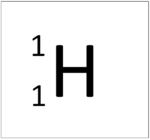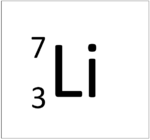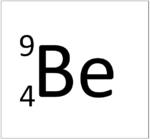Difference between revisions of "Proton"
(→About Protons) |
|||
| (5 intermediate revisions by 2 users not shown) | |||
| Line 31: | Line 31: | ||
===About Protons=== | ===About Protons=== | ||
| + | : The [[proton]] is denoted with a lower case '''p'''. | ||
: A [[proton]] is one of two [[baryon]]s found in the [[Atomic Nucleus|atomic nucleus]]. | : A [[proton]] is one of two [[baryon]]s found in the [[Atomic Nucleus|atomic nucleus]]. | ||
: [[Proton]]s have a [[Electrical Charge|charge]] of 1.60x10<sup>-19</sup> [[Coulomb]]s (the [[Elementary Charge|elementary charge]]) and a [[mass]] of 1.67x10<sup>-27</sup>kg. | : [[Proton]]s have a [[Electrical Charge|charge]] of 1.60x10<sup>-19</sup> [[Coulomb]]s (the [[Elementary Charge|elementary charge]]) and a [[mass]] of 1.67x10<sup>-27</sup>kg. | ||
| Line 46: | Line 47: | ||
[[Proton]] | [[Proton]] | ||
| style="height:20px; width:100px; text-align:center;"|<math>uud</math> | | style="height:20px; width:100px; text-align:center;"|<math>uud</math> | ||
| − | | style="height:20px; width:100px; text-align:center;"|<math> | + | | style="height:20px; width:100px; text-align:center;"|<math>Q=+1</math> |
| style="height:20px; width:100px; text-align:center;"|<math>S=0</math> | | style="height:20px; width:100px; text-align:center;"|<math>S=0</math> | ||
| − | | style="height:20px; width:100px; text-align:center;"|<math> | + | | style="height:20px; width:100px; text-align:center;"|<math>B=+1</math> |
| − | | style="height:20px; width:100px; text-align:center;"|<math> | + | | style="height:20px; width:100px; text-align:center;"|<math>L=0</math> |
|- | |- | ||
| style="height:20px; width:100px; text-align:center;"| | | style="height:20px; width:100px; text-align:center;"| | ||
[[Antiproton]] | [[Antiproton]] | ||
| style="height:20px; width:100px; text-align:center;"|<math>\bar{u}\bar{u}\bar{d}</math> | | style="height:20px; width:100px; text-align:center;"|<math>\bar{u}\bar{u}\bar{d}</math> | ||
| − | | style="height:20px; width:100px; text-align:center;"|<math> | + | | style="height:20px; width:100px; text-align:center;"|<math>Q=-1</math> |
| style="height:20px; width:100px; text-align:center;"|<math>S=0</math> | | style="height:20px; width:100px; text-align:center;"|<math>S=0</math> | ||
| − | | style="height:20px; width:100px; text-align:center;"|<math> | + | | style="height:20px; width:100px; text-align:center;"|<math>B=-1</math> |
| − | | style="height:20px; width:100px; text-align:center;"|<math> | + | | style="height:20px; width:100px; text-align:center;"|<math>L=0</math> |
|} | |} | ||
| + | |||
| + | |||
| + | ===References=== | ||
| + | ====AQA==== | ||
| + | |||
| + | :[https://www.amazon.co.uk/gp/product/0008158770/ref=as_li_tl?ie=UTF8&camp=1634&creative=6738&creativeASIN=0008158770&linkCode=as2&tag=nrjc-21&linkId=ec31595e720e1529e49876c3866fff6e ''Proton, pages 108-11, 133, GCSE Physics; Student Book, Collins, AQA ''] | ||
| + | :[https://www.amazon.co.uk/gp/product/0008158762/ref=as_li_tl?ie=UTF8&camp=1634&creative=6738&creativeASIN=0008158762&linkCode=as2&tag=nrjc-21&linkId=a0fffa35b3ea49a63404f6704e0df7cc ''Proton, pages 13, 24-5, GCSE Chemistry; Student Book, Collins, AQA ''] | ||
| + | :[https://www.amazon.co.uk/gp/product/1471851370/ref=as_li_tl?ie=UTF8&camp=1634&creative=6738&creativeASIN=1471851370&linkCode=as2&tag=nrjc-21&linkId=01c69b0ae058f809cf636033e6ba793e ''Protons, page 88, GCSE Physics, Hodder, AQA ''] | ||
| + | :[https://www.amazon.co.uk/gp/product/1471851354/ref=as_li_tl?ie=UTF8&camp=1634&creative=6738&creativeASIN=1471851354&linkCode=as2&tag=nrjc-21&linkId=9012a0d354024419214fb3ad5ac44ba0 ''Protons, pages 117-18, 338, 339, GCSE Combined Science Trilogy 1, Hodder, AQA ''] | ||
| + | :[https://www.amazon.co.uk/gp/product/1782945571/ref=as_li_tl?ie=UTF8&camp=1634&creative=6738&creativeASIN=1782945571&linkCode=as2&tag=nrjc-21&linkId=9e29fad914244909903e5e93f8a01d216 ''Protons, pages 12, 13, 19, 21, GCSE Chemistry; The Revision Guide, CGP, AQA ''] | ||
| + | :[https://www.amazon.co.uk/gp/product/1782945970/ref=as_li_tl?ie=UTF8&camp=1634&creative=6738&creativeASIN=1782945970&linkCode=as2&tag=nrjc-21&linkId=a120d24dcc7cc7a58192069a3aafc1d2 ''Protons, pages 122, 123, GCSE Physics; The Complete 9-1 Course for AQA, CGP, AQA ''] | ||
| + | :[https://www.amazon.co.uk/gp/product/0198359381/ref=as_li_tl?ie=UTF8&camp=1634&creative=6738&creativeASIN=0198359381&linkCode=as2&tag=nrjc-21&linkId=47c8d1ae58d8b3a5e2094cd447154558 ''Protons, pages 13-15, GCSE Chemistry; Third Edition, Oxford University Press, AQA ''] | ||
| + | :[https://www.amazon.co.uk/gp/product/178294639X/ref=as_li_tl?ie=UTF8&camp=1634&creative=6738&creativeASIN=178294639X&linkCode=as2&tag=nrjc-21&linkId=51599bb45a2bfaf7c1b6a978b2ca2616 ''Protons, pages 22-25, 43, 70, GCSE Combined Science Trilogy; Chemistry, CGP, AQA ''] | ||
| + | :[https://www.amazon.co.uk/gp/product/1782945962/ref=as_li_tl?ie=UTF8&camp=1634&creative=6738&creativeASIN=1782945962&linkCode=as2&tag=nrjc-21&linkId=476bb5c8d1dfb5c08ac81b6d4d1c98d8 ''Protons, pages 22-25, 43, 72, GCSE Chemistry, CGP, AQA ''] | ||
| + | :[https://www.amazon.co.uk/gp/product/1471851346/ref=as_li_tl?ie=UTF8&camp=1634&creative=6738&creativeASIN=1471851346&linkCode=as2&tag=nrjc-21&linkId=3ac654f4b0da781c49c855a1af4c92ea ''Protons, pages 2-3, GCSE Chemistry, Hodder, AQA ''] | ||
| + | :[https://www.amazon.co.uk/gp/product/178294558X/ref=as_li_tl?ie=UTF8&camp=1634&creative=6738&creativeASIN=178294558X&linkCode=as2&tag=nrjc-21&linkId=f0dfb66dafcb0c6e9449e7b1a4ae1ac381 ''Protons, pages 43-45, GCSE Physics; The Revision Guide, CGP, AQA ''] | ||
| + | :[https://www.amazon.co.uk/gp/product/019835939X/ref=as_li_tl?ie=UTF8&camp=1634&creative=6738&creativeASIN=019835939X&linkCode=as2&tag=nrjc-21&linkId=57e96876985fc39b1a3d8a3e3dc238b6 ''Protons, pages 50,95, GCSE Physics; Third Edition, Oxford University Press, AQA ''] | ||
| + | :[https://www.amazon.co.uk/gp/product/1782945598/ref=as_li_tl?ie=UTF8&camp=1634&creative=6738&creativeASIN=1782945598&linkCode=as2&tag=nrjc-21&linkId=ad276ad49df77ab4b40ab4fd0fe10206 ''Protons, pages 96, 97, 104, 197, 198, GCSE Combined Science; The Revision Guide, CGP, AQA ''] | ||
| + | :[https://www.amazon.co.uk/gp/product/1782946403/ref=as_li_tl?ie=UTF8&camp=1634&creative=6738&creativeASIN=1782946403&linkCode=as2&tag=nrjc-21&linkId=32a0abb60dff015b15b50e9b1d7b4644 ''Protons, pages, 110, 111, GCSE Combined Science Trilogy; Physics, CGP, AQA ''] | ||
| + | :[https://www.amazon.co.uk/gp/product/1471851370/ref=as_li_tl?ie=UTF8&camp=1634&creative=6738&creativeASIN=1471851370&linkCode=as2&tag=nrjc-21&linkId=01c69b0ae058f809cf636033e6ba793e ''Protons; atomic number and mass number, page 89, GCSE Physics, Hodder, AQA ''] | ||
| + | |||
| + | ====Edexcel==== | ||
| + | |||
| + | :[https://www.amazon.co.uk/gp/product/1782945725/ref=as_li_tl?ie=UTF8&camp=1634&creative=6738&creativeASIN=1782945725&linkCode=as2&tag=nrjc-21&linkId=694be7494de75af3349537d34e13f7f0 ''Protons, page 16, GCSE Chemistry; The Revision Guide, CGP, Edexcel ''] | ||
| + | :[https://www.amazon.co.uk/gp/product/1292120215/ref=as_li_tl?ie=UTF8&camp=1634&creative=6738&creativeASIN=1292120215&linkCode=as2&tag=nrjc-21&linkId=8f96ddb76196848bafdb124354e4cf77 ''Protons, page 18, GCSE Chemistry, Pearson, Edexcel ''] | ||
| + | :[https://www.amazon.co.uk/gp/product/1782945741/ref=as_li_tl?ie=UTF8&camp=1634&creative=6738&creativeASIN=1782945741&linkCode=as2&tag=nrjc-21&linkId=30da4f2178da182547b62a7329d13b57 ''Protons, page 79, GCSE Combined Science; The Revision Guide, CGP, Edexcel ''] | ||
| + | :[https://www.amazon.co.uk/gp/product/1782948163/ref=as_li_tl?ie=UTF8&camp=1634&creative=6738&creativeASIN=1782948163&linkCode=as2&tag=nrjc-21&linkId=0fdbfd5dd397d6e24a9dfb250f08587f ''Protons, pages 152, 155, GCSE Physics, CGP, Edexcel ''] | ||
| + | :[https://www.amazon.co.uk/gp/product/1782948147/ref=as_li_tl?ie=UTF8&camp=1634&creative=6738&creativeASIN=1782948147&linkCode=as2&tag=nrjc-21&linkId=f63dcd8345f4e49c717b39a228a36c7c ''Protons, pages 33-37, GCSE Chemistry, CGP, Edexcel ''] | ||
| + | :[https://www.amazon.co.uk/gp/product/1292120223/ref=as_li_tl?ie=UTF8&camp=1634&creative=6738&creativeASIN=1292120223&linkCode=as2&tag=nrjc-21&linkId=068ecf40278c32406a7f1c6e66751417 ''Protons, pages 92, 140, GCSE Physics, Pearson Edexcel ''] | ||
| + | |||
| + | ====OCR==== | ||
| + | :[https://www.amazon.co.uk/gp/product/1782945679/ref=as_li_tl?ie=UTF8&camp=1634&creative=6738&creativeASIN=1782945679&linkCode=as2&tag=nrjc-21&linkId=a2db42f7b4bdf10cafaafa3bb9120940 ''Protons, pages 14, 15, Gateway GCSE Chemistry; The Revision Guide, CGP, OCR ''] | ||
| + | :[https://www.amazon.co.uk/gp/product/0198359837/ref=as_li_tl?ie=UTF8&camp=1634&creative=6738&creativeASIN=0198359837&linkCode=as2&tag=nrjc-21&linkId=3c4229e8b023b2b60768e7ea2307cc6f ''Protons, pages 20-21, 170-171, 179, Gateway GCSE Physics, Oxford, OCR ''] | ||
| + | :[https://www.amazon.co.uk/gp/product/0198359829/ref=as_li_tl?ie=UTF8&camp=1634&creative=6738&creativeASIN=0198359829&linkCode=as2&tag=nrjc-21&linkId=90e8d7b4f039d53035238fa0320fe00b ''Protons, pages 27, 28-29, Gateway GCSE Chemistry, Oxford, OCR ''] | ||
| + | :[https://www.amazon.co.uk/gp/product/1782945695/ref=as_li_tl?ie=UTF8&camp=1634&creative=6738&creativeASIN=1782945695&linkCode=as2&tag=nrjc-21&linkId=ceafcc80bcad6b6754ee97a0c7ceea53 ''Protons, pages 84-86, 150, 195, Gateway GCSE Combined Science; The Revision Guide, CGP, OCR ''] | ||
Latest revision as of 17:08, 18 December 2019
Contents
Key Stage 4
Meaning
The Proton is a positively charged particle found in the nucleus of an atom.
About Protons
- Protons are a type of nucleon.
- Protons have a relative atomic charge of +1 and a relative atomic mass of 1.
| Hydrogen | Helium | Lithium | Beryllium |
| This atom has an Atomic Number (Z) of 1 therefore it contains 1 proton. | This atom has an Atomic Number (Z) of 2 therefore it contains 2 proton. | This atom has an Atomic Number (Z) of 3 therefore it contains 3 proton. | This atom has an Atomic Number (Z) of 4 therefore it contains 4 proton. |
Key Stage 5
Meaning
A proton (p) is a baryon made from 2 up-quarks and 1 down-quark.
About Protons
- The proton is denoted with a lower case p.
- A proton is one of two baryons found in the atomic nucleus.
- Protons have a charge of 1.60x10-19 Coulombs (the elementary charge) and a mass of 1.67x10-27kg.
- A proton is the most stable hadron with a half life longer than the age of the Universe.
| Subatomic Particle | Quark-composition | Charge/e | Strangeness | Baryon Number | Lepton Number |
| \(uud\) | \(Q=+1\) | \(S=0\) | \(B=+1\) | \(L=0\) | |
| \(\bar{u}\bar{u}\bar{d}\) | \(Q=-1\) | \(S=0\) | \(B=-1\) | \(L=0\) |
References
AQA
- Proton, pages 108-11, 133, GCSE Physics; Student Book, Collins, AQA
- Proton, pages 13, 24-5, GCSE Chemistry; Student Book, Collins, AQA
- Protons, page 88, GCSE Physics, Hodder, AQA
- Protons, pages 117-18, 338, 339, GCSE Combined Science Trilogy 1, Hodder, AQA
- Protons, pages 12, 13, 19, 21, GCSE Chemistry; The Revision Guide, CGP, AQA
- Protons, pages 122, 123, GCSE Physics; The Complete 9-1 Course for AQA, CGP, AQA
- Protons, pages 13-15, GCSE Chemistry; Third Edition, Oxford University Press, AQA
- Protons, pages 22-25, 43, 70, GCSE Combined Science Trilogy; Chemistry, CGP, AQA
- Protons, pages 22-25, 43, 72, GCSE Chemistry, CGP, AQA
- Protons, pages 2-3, GCSE Chemistry, Hodder, AQA
- Protons, pages 43-45, GCSE Physics; The Revision Guide, CGP, AQA
- Protons, pages 50,95, GCSE Physics; Third Edition, Oxford University Press, AQA
- Protons, pages 96, 97, 104, 197, 198, GCSE Combined Science; The Revision Guide, CGP, AQA
- Protons, pages, 110, 111, GCSE Combined Science Trilogy; Physics, CGP, AQA
- Protons; atomic number and mass number, page 89, GCSE Physics, Hodder, AQA
Edexcel
- Protons, page 16, GCSE Chemistry; The Revision Guide, CGP, Edexcel
- Protons, page 18, GCSE Chemistry, Pearson, Edexcel
- Protons, page 79, GCSE Combined Science; The Revision Guide, CGP, Edexcel
- Protons, pages 152, 155, GCSE Physics, CGP, Edexcel
- Protons, pages 33-37, GCSE Chemistry, CGP, Edexcel
- Protons, pages 92, 140, GCSE Physics, Pearson Edexcel



